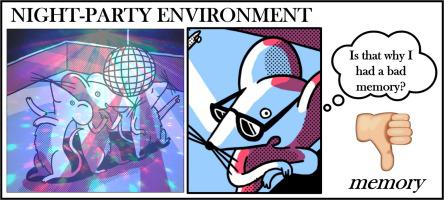当前位置:
X-MOL 学术
›
Appl. Acoust.
›
论文详情
Our official English website, www.x-mol.net, welcomes your
feedback! (Note: you will need to create a separate account there.)
Implications of night-party environment on emotional, physiological, and anatomical features in mammals: A simulation based study on Swiss mice
Applied Acoustics ( IF 3.4 ) Pub Date : 2020-10-01 , DOI: 10.1016/j.apacoust.2020.107404 Amanda Pereira da Costa Araújo , Ítalo Nascimento Freitas , Alex Rodrigues Gomes , Guilherme Malafaia
Applied Acoustics ( IF 3.4 ) Pub Date : 2020-10-01 , DOI: 10.1016/j.apacoust.2020.107404 Amanda Pereira da Costa Araújo , Ítalo Nascimento Freitas , Alex Rodrigues Gomes , Guilherme Malafaia

|
Abstract Audiovisual superstimuli at night parties have been concerning parents and public health authorities, mainly when it comes to the risk of drug abuse and violence. However, the effects of such stimuli on the mental health of night-party goers are little known. Thus, the aim of the present study was to evaluate whether Swiss mice exposure to night-party environment simulations induces locomotor damages and predictive behavioral changes such as anxiety and memory deficit. Animals were exposed to audiovisual stimuli simulating a night-party environment for five consecutive days (6 h/day). Based on the collected data, the locomotor activity and the emotional state of animals subjected to audiovisual superstimuli [group sound (S) + light (L)] did not differ from the records of animals exposed to sound (group S) or visual (group V) stimulus in separate, or even from those of animals in the control group (C). Serum cortisol levels and results of histological analyses applied to the suprarenal glands suggested that the animals did not suffer stress due to the exposure procedure. However, mice in the S + L group recorded lower recognition index than the ones in the control group in the object recognition memory test, as well as lower latency to descend the platform in the inhibitory avoidance test. Therefore, the audiovisual superstimuli affected the short-term memory, which is related to object recognition and to aversive memory recall. To the best of our knowledge, the present study is novel in developing an apparatus and an exposure protocol to simulate a night-party environment to be used in further laboratory trials. In addition, results have shown that cognitive processes linked to short-term and aversive memory can be affected by audiovisual superstimuli; therefore, the current research warns about mental damages likely caused by night-party environments.
中文翻译:

夜间聚会环境对哺乳动物情绪、生理和解剖特征的影响:基于瑞士小鼠的模拟研究
摘要 夜间派对的视听超级刺激一直与父母和公共卫生当局有关,主要是在涉及滥用药物和暴力的风险时。然而,这种刺激对夜派对者心理健康的影响鲜为人知。因此,本研究的目的是评估瑞士小鼠暴露于夜间派对环境模拟是否会引起运动损伤和预测性行为变化,如焦虑和记忆缺陷。动物连续五天(6 小时/天)暴露于模拟夜间派对环境的视听刺激。根据收集到的数据,受到视听超刺激[组声音(S)+光(L)]的动物的运动活动和情绪状态与单独暴露于声音(S组)或视觉(V组)刺激的动物的记录没有区别,甚至来自对照组(C)中的动物。应用于肾上腺的血清皮质醇水平和组织学分析结果表明,动物并未因暴露程序而遭受压力。然而,S+L组小鼠在物体识别记忆测试中的识别指数低于对照组,在抑制性回避测试中下平台的潜伏期也较低。因此,视听超级刺激影响了短期记忆,这与物体识别和厌恶性记忆回忆有关。据我们所知,本研究在开发设备和暴露协议以模拟夜间聚会环境以用于进一步的实验室试验方面是新颖的。此外,结果表明,与短期和厌恶记忆相关的认知过程会受到视听超刺激的影响;因此,目前的研究警告夜间聚会环境可能造成的精神损害。
更新日期:2020-10-01
中文翻译:

夜间聚会环境对哺乳动物情绪、生理和解剖特征的影响:基于瑞士小鼠的模拟研究
摘要 夜间派对的视听超级刺激一直与父母和公共卫生当局有关,主要是在涉及滥用药物和暴力的风险时。然而,这种刺激对夜派对者心理健康的影响鲜为人知。因此,本研究的目的是评估瑞士小鼠暴露于夜间派对环境模拟是否会引起运动损伤和预测性行为变化,如焦虑和记忆缺陷。动物连续五天(6 小时/天)暴露于模拟夜间派对环境的视听刺激。根据收集到的数据,受到视听超刺激[组声音(S)+光(L)]的动物的运动活动和情绪状态与单独暴露于声音(S组)或视觉(V组)刺激的动物的记录没有区别,甚至来自对照组(C)中的动物。应用于肾上腺的血清皮质醇水平和组织学分析结果表明,动物并未因暴露程序而遭受压力。然而,S+L组小鼠在物体识别记忆测试中的识别指数低于对照组,在抑制性回避测试中下平台的潜伏期也较低。因此,视听超级刺激影响了短期记忆,这与物体识别和厌恶性记忆回忆有关。据我们所知,本研究在开发设备和暴露协议以模拟夜间聚会环境以用于进一步的实验室试验方面是新颖的。此外,结果表明,与短期和厌恶记忆相关的认知过程会受到视听超刺激的影响;因此,目前的研究警告夜间聚会环境可能造成的精神损害。











































 京公网安备 11010802027423号
京公网安备 11010802027423号